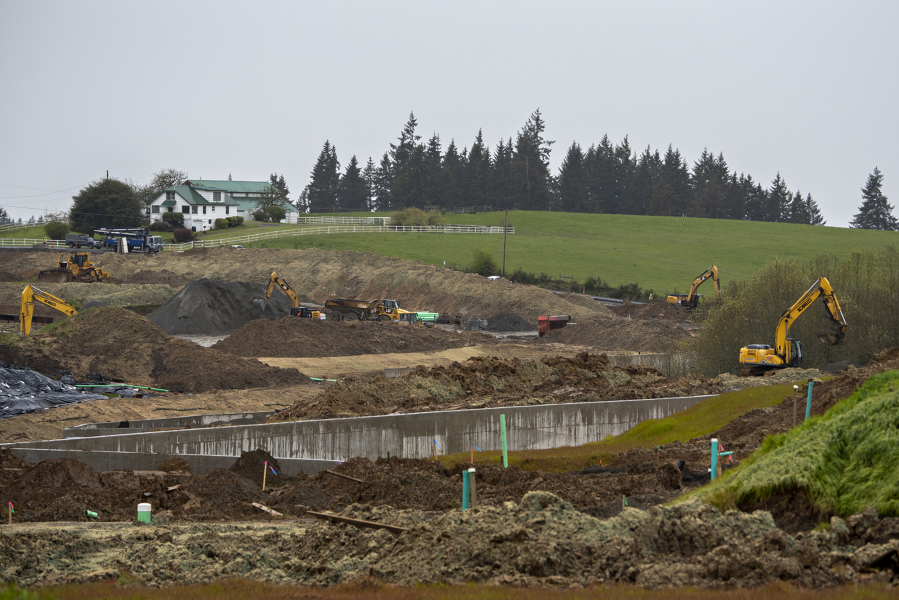It’s no secret that many Clark County residents struggle to find affordable housing. Both rental and purchase prices have continued to climb while the supply of available housing has dwindled.
The Clark County Council is working to identify and implement solutions that will help alleviate the housing crisis through the Housing Options Study and Action Plan.
Residents will have the chance to review the plan and offer comment during a public hearing set for 6 p.m. Tuesday.
“The purpose of the housing study is to really understand the local challenges with a focus on the Vancouver urban growth area,” said Oliver Orjiako, director of community planning, at the council’s May 4 meeting.
“The process started with a way to encourage the creation of affordable housing for low- and moderate-income households by looking at removing regulatory barriers and considering strategies.”
Orjiako said the study wasn’t only focused on immediate solutions but also looked for ways to provide affordable housing opportunities for generations to come. He said the study focused on the urban growth area partly because it is the area the county council manages, but also because it includes housing types — such as apartment buildings, condominiums and townhouses — not typically found in rural areas.
Recommendations included in the action plan are aimed at short-, mid- and long-term solutions. Some can be put in place immediately, while others will require changes to the county’s zoning and land-use policies along with its comprehensive plan. Examples of recommendations include regulatory strategies to expand housing options, increasing subsidized housing for low-income households, collaborating with partners on housing programs, and advocating for state legislative changes.
Too many big houses?
One issue key to the study’s findings and recommendations, and likely to face resistance from some residents and council members, is increased housing density.
“Single-family, owner-occupied dwellings are the predominant housing type in the county but do not reflect the entirety of local needs. Nearly 60 percent of households are one- to two-person households, but 70 percent of the stock is three- and four-bedroom units,” Steve Faust, from project partner 3J Consulting, said during the council meeting.
While communities comprised primarily of single-family homes are popular and have their benefits, they also have their drawbacks. Research published in the Journal of American Planning Association found single-family neighborhoods negatively impact the environment: They promote suburban sprawl and greater reliance on single-driver cars, restrict the supply of available housing and keep lower-income households out of high-opportunity neighborhoods.
For many, though, higher-density neighborhoods are not just unattractive but lead to urban blight and higher crime rates.
“I certainly applaud, as everyone does, the goals of affordability and the diversity of housing we need to have in our county,” said Chair Karen Bowerman. “I’m saddened, though, to see that the goals are basically achieved by building more densely and removing places to park, rather than focusing on some of the things that are a little bit tougher to address.”
Bowerman said she wanted to see more focus on speeding up the permitting process, which in turn affects costs to builders; making construction aggregate cheaper and more readily available; and increasing the availability of residential buildable lands.
Bowerman said she was concerned by the emphasis put on changing the character of an area because of the impacts it could have such as increased risks to safety and the lack of space for neighborhood commercial businesses.
“I have lived in a community that tried to address affordability and diversity of housing, and they did it in this manner. What happened was the development of very tight (parking) spaces where people basically couldn’t move. There were cars jammed into the streets, there was tandem parking everywhere that made it so that it was downright dangerous for people to move cars out of their driveways. It was difficult for pedestrians, if not impossible, and yet there were skateboarders there and kids on bicycles out in the streets,” she said.
Instead of allowing apartment buildings in areas zoned for commercial use, Bowerman said, the county should set aside additional residential land.
Kamp noted that many of those strategies Bowerman wants to see addressed are included in the mid- and long-term recommendations.
Councilor Richard Rylander Jr. said he had similar concerns about the recommendations’ focus on increasing housing density by packing “more people into smaller spaces.”
“One of the things I’ve noted in my travels over the years is as you get into higher density, where they reduce the number of parking spaces per unit — and yet because of affordability issues with the housing units you pack more people into the apartments or the houses — and you end up getting more vehicles, which then compounds problems in the local area for traffic, parking, etc.,” Rylander said at the meeting.
Rylander said he expected only people living in neighborhoods that will be affected by any density changes to speak out, adding that the county should be prepared for that pushback and reach out to those residents prior to changes being made.
“Recommendations around having more density, less parking, those types of things generally get pushback from community members,” Andy Silver, chief operating officer for the Vancouver Housing Authority, said in an interview Monday. “We’re certainly not the first community to have this conversation.”
Silver said there are trade-offs with increased housing density, which aren’t always explained well to community members or elected officials.
“They’re thinking about, ‘Do I want more parking or less parking?’ If those are the two options, and there are no other things to think about, they say, ‘More parking,’” Silver said. “The sort of tragedy there is the community is also very upset about unsheltered homelessness, about it increasing in the community and about the effects, both for the people experiencing it and the effects it’s having on people who are housed.”
Density and homelessness
Silver said there is a very clear correlation between the issues of housing density and homelessness.
“When we think about homelessness, we often confuse predictive factors and root cause,” he said. “We think of things like mental illness, substance abuse disorders, domestic violence, physical health, etc. We think of those as root causes, but they’re actually predictive factors.”
Silver said those factors make it more likely that a specific individual or family will experience homelessness, but the root cause is still housing — or the lack of it.
Silver said it is not rates of mental illness or substance abuse that accurately predict whether the rate of homelessness will increase for a community, but rather the cost of housing, its availability and vacancy rates.
“One thing to remember is the area that’s being discussed, the urban growth area around Vancouver, that’s a very specific area. We’re not talking about all of Clark County and the cities and towns with it. Nobody is advocating to get rid of single-family homes,” he added. “What they’re advocating for is that people should have the choice.”
Silver said having that choice will mean removing some of the current regulations that block builders and developers from putting up higher-density projects.
Recommendations from the study already have the blessing of the county’s planning commission. At its April 21 meeting, the commission unanimously approved a recommendation to the county council to approve the plan and direct staff to begin implementation of the short-term strategies.
“There are a lot of things we can’t control. We can’t control interest rates; we can’t control the price of materials; we can’t control incomes,” Planning Commissioner Bryan Halbe said at the meeting. “But what we can control, what we can play a part of, is helping to remove the barriers to affordable housing. I think this plan is that start.”
For links to the public hearing or an agenda, go to https://clark.wa.gov/calendar.




